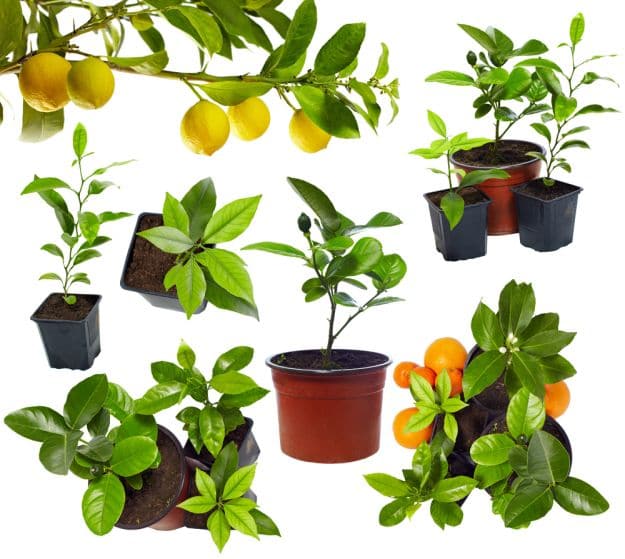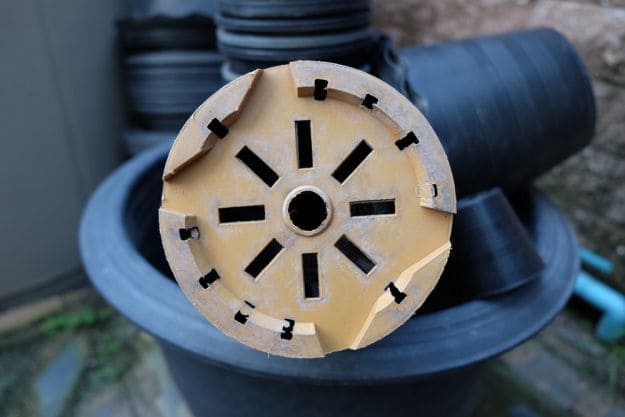Growing fruit trees in containers is an excellent option for many homesteaders, or fruit lovers, of all kinds to grow fruit at home! If you’ve ever dreamed of growing your own fruit but haven’t found the space, then you’re in luck! Here are 7 secrets to getting the fruit orchard of your dream in a small confined space.
How To Grow Fruit Trees In Containers
Fruit trees are such a big hit for homesteaders. Who wouldn’t want free, fresh, delicious fruit growing in their yard? However, folks living in urban areas very rarely have fruit trees due to lack of space. Read along and you’ll learn how to make growing your own fruit possible even with very little space.
Secret # 1: Choose A Dwarf Rootstock

When choosing a fruit tree, look for dwarf or semidwarf varieties. Unlike regular fruit trees, dwarf fruit trees will only grow to be about 8 ft tall. They will also have a thinner main leader stem, meaning they will be less wide. Despite being so small, these trees will produce just as much fruit as a regular tree would, and the fruit will be the same size.
Secret # 2: Choose A “Cone” Shaped Tree

When a tree has already been trained to grow in a conelike shape, it will take up a lot less space when it matures. Conelike means that the branches grow at a 45-degree angle upwards. Don’t choose a tree that has too many branches growing at 90 degrees. If you do see these branches, snip them off while they are young to prevent problems later on.
Secret # 3: Use A Plastic Container

Never use wooden containers (unless it is lined with plastic) for your fruit tree. Wood likes to absorb the moisture from the soil, leaving the soil dry and free from important nutrients. Likewise, never use Terra Cotta pots either; these soak up water and have the tendency of cracking and splitting when under too much pressure.
Plastic is the most ideal material for fruit trees for the following reasons:
- it keeps soil from freezing in the winter
- it keeps the soil cool and moist in the summer
- it is able to withstand lots of pressure
- it is very lightweight, so it is easy to move around
Secret # 4: Train Your Tree

Training a trees’ roots is very important as it will make them used to boundaries, and the ability to grow with limited space. To train your tree this way, you will need multiple pots. Once your tree is rootbound (meaning the roots have spread all over the pot and are starting to come out of the drainage holes), you will need to wait a month and then repot into a bigger pot. Once the roots are rootbound again in the second pot, repot it again, and then again, and again until you end up with the best pot size. The pots may be just a couple liters larger than the one before, the size difference doesn’t really matter as long as the new pot is larger than the one before.
Secret # 5: Use Potting Soil

Many people think that trees require Tree Soil even when the tree is to be grown in a pot. This is not true. Instead, use potting soil. Potting soil is light and fluffy, and will not put too much pressure on the roots. Since potting soil is a bit too fluffy, make sure to somehow compact the soil. You can water it down as a way to do this, or simply use your hands to press it down.
Secret # 6: Have Plenty of Drainage Holes

You are probably used to poking holes at the bottom of your flower pots, right? We all know that proper drainage is essential for container gardening. It is even more necessary for growing fruit trees in pots. Unlike other plants, most fruit trees grow better in very dry soil than in very wet soil. They hate wet soil. In fact, more than 50% of fruit tree diseases are caused by overlywet soil. So, it is very important that excess water is able to freely flow out of the pot. For a container that has a base circumference of 20 inches, drill about 5 1cm drainage holes.
Secret # 7: Fertilize With Appropriate Nutrients

Nitrogen in fertilizers makes leaves and new stems grow faster and better, thus less of the tree’s energy is spent on producing fruit. So when choosing a fertilizer, don’t choose one with too much nitrogen. A water soluble fertilizer is the best. Fertilizer spikes are not recommended for fruit trees in containers unless written otherwise on the product. Never fertilize in late fall or winter months. The tree does not want to produce any new growth during this season so you should not force it. Fertilizing in fall and winter could mess up the trees winterstate and cause problems.
Last Tip:
Plant some shallowroot, groundcover flowers as well. This will act as mulch and add a bit of character to the pot!
Space will never be an issue again in growing fruit trees. Growing fruit trees is now very much doable and you don’t need a huge space to grow fruit trees, you just need containers and the proper care. Pick, grow, harvest, and enjoy with your beautiful fruit tree in a container!
Thanks for checking our post for secrets to growing fruit trees in containers! Did you find it helpful and interesting? Let us know in the comments below.
Want to learn how use recyclable material into a planter? Check out here DIY Bottle Planter From Recyclables, an easy DIY perfect for seed starting!
Follow us on Instagram, twitter, pinterest, and facebook!
This post was originally published in July 2016 and has been updated for quality and relevancy.


your notes are very important to me , I really love it.
Question, instead of repotting my plant, can i just use a big plastic container like 32 gallon to plant my avocado tree?
Why when giving measurements don’t you include both – inches and meters or cm?